Smarter & More Informative Search Results
January 13th, 2025 by Alex Zorach
Users have requested we make our search "smarter", and we are pleased to announce progress on this front. Last summer we announced search improvements that return unlinked records to external websites when a scientific name search returns no results. Behind-the-scenes, this system has been notifying us of the searches so we can interlink the corresponding records after resolving any taxonomic disparities. This process has taken a lot of time and work but is already yielding results, as we are seeing fewer unmatched searches over time.Today we announce a more visible improvement. When typing in a scientific synonym or alternate common name, our search not only matches synonyms and alternate names, but shows which record each matched name points to. The notation involves multiple lines: the first line shows the record matched in our system, with the accepted scientific name in our treatment; next to this name is the authority (original author) of the accepted name. The second line shows the match to the search query, a different name that refers to the same taxon under our treatment. An arrow pointing up shows which synonym points to which record.
The Same Scientific Name Can Point To Different Species
Note that searches for a single name may return multiple records because different authors may use the same name to refer to different taxa. Our search improvements aim to concisely communicate these relationships.Here is an example:
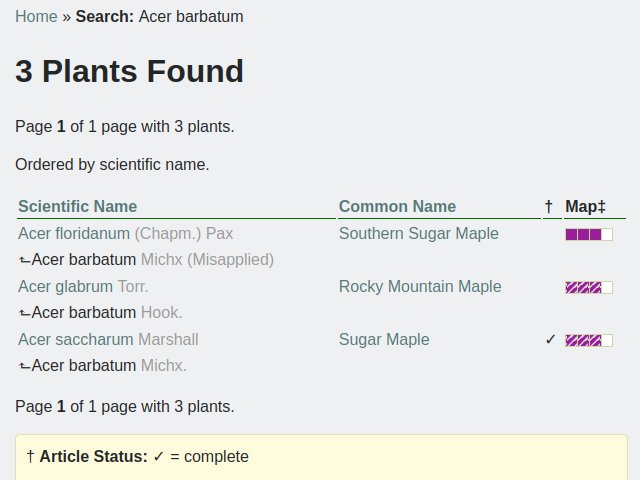 This screenshot shows the results when the scientific name Acer barbatum is typed into the search box. This name is not accepted under our treatment, but rather, is treated as a synonym of three different species, depending on which author's use of the name is referenced. The name has been coined by two authors, William Jackson Hooker (abbreviated Hook) and André Michaux (Michaux). Hooker used the name to describe a specimen which was later found to be the already-described Rocky Mountain maple (Acer glabrum), whereas Michaux did the same for sugar maple (Acer saccharum). However, Michaux's name was misapplied for years to refer to southern sugar maple (Acer floridanum) and this usage may actually be the most widespread.
This screenshot shows the results when the scientific name Acer barbatum is typed into the search box. This name is not accepted under our treatment, but rather, is treated as a synonym of three different species, depending on which author's use of the name is referenced. The name has been coined by two authors, William Jackson Hooker (abbreviated Hook) and André Michaux (Michaux). Hooker used the name to describe a specimen which was later found to be the already-described Rocky Mountain maple (Acer glabrum), whereas Michaux did the same for sugar maple (Acer saccharum). However, Michaux's name was misapplied for years to refer to southern sugar maple (Acer floridanum) and this usage may actually be the most widespread.If you click on any of these articles, the top of the article will show taxonomy notes clarifying relevant details in more depth.
If you are having trouble resolving author names, you may find Wikipedia's List of botanists by author abbreviation helpful.
Searching for Species That Have Been Split
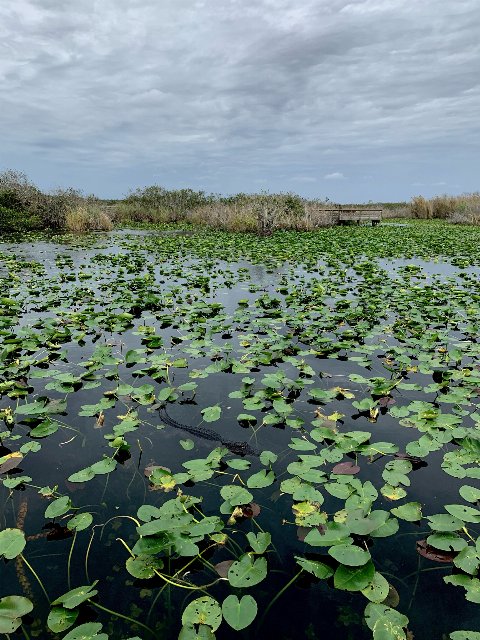 The yellow pond lily is one species that has been split, such that what was once referred to by the name Nuphar lutea is now referred to by various names. The plant pictured here is spatterdock (Nuphar advena); if you look closely there is a large friend under the water utilizing the same habitat. Photo © Zach E Plants, CC BY 4.0, Source.
The yellow pond lily is one species that has been split, such that what was once referred to by the name Nuphar lutea is now referred to by various names. The plant pictured here is spatterdock (Nuphar advena); if you look closely there is a large friend under the water utilizing the same habitat. Photo © Zach E Plants, CC BY 4.0, Source.In some cases, a species has been split, and what were formerly considered to be sub-taxa of a single species (such as varieties or subspecies) are now considered to be separate species. The search now does more-or-less the same thing for the sub-taxa, showing which names point to which species. The return of multiple records in this case is important, because a person searching for a particular name might not know that the taxon referred to by the name has been split in our treatment.
An illustrative example of a multi-way split is seen in this search for Nuphar lutea:
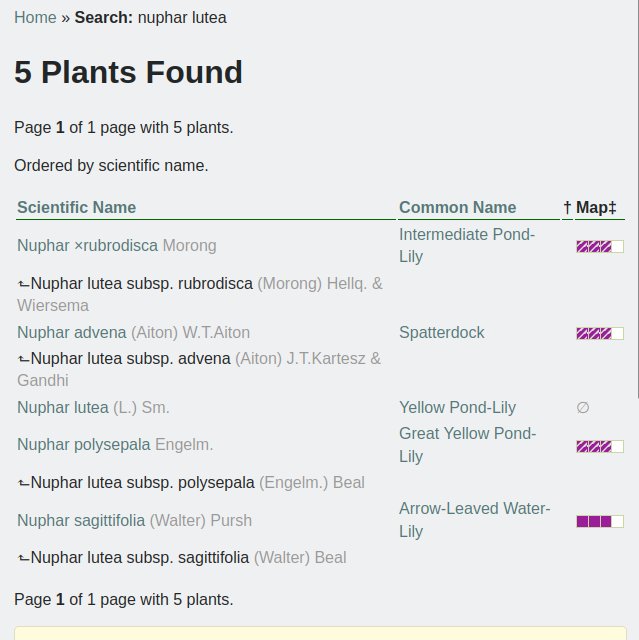 Nuphar lutea is universally-agreed to refer to the species yellow pond-lily (Nuphar lutea). However, previously, this species was thought to include populations all around the Northern Hemisphere, in both North America and Eurasia. Recent work split it into numerous different species, with what were formerly considered subspecies now treated as proper species. The original name now only refers to a Eurasian species that does not occur in North America.
Nuphar lutea is universally-agreed to refer to the species yellow pond-lily (Nuphar lutea). However, previously, this species was thought to include populations all around the Northern Hemisphere, in both North America and Eurasia. Recent work split it into numerous different species, with what were formerly considered subspecies now treated as proper species. The original name now only refers to a Eurasian species that does not occur in North America.Our search not only matches this species (with a stub article explaining the split) but also four former subspecies, pointing to the respective species they have been renamed to.
Yet another phenomenon that our search matches in this manner are misspellings and alternate endings. Alternate endings in scientific names are common because the names are in Latin, and the conventions for naming can sometimes cause disagreement between declension and/or grammatical gender (of which Latin has 3.) Authors fluent in Latin will occasionally "correct" a name, which then conflicts with the conventions of taxonomy, in which the oldest name is accepted. One such example is betatakin fiddleleaf (Nama retrorsum), where the mismatched name is the accepted one, but the "corrected" name Nama retrorsa where the genders match is more widely used. Alternate endings are also common in third-declension nouns, because the gender is not as clear from the noun itself, such as how flax-leaved stiff-aster (Ionactis linariifolia) is also referred to as Ionactis linariifolius. In some cases, the accepted name has matched genders, but people sometimes use alternate names with mismatched genders anyway, such as with piedmont leather-root (Orbexilum lupinellum), where the mismatched name Orbexilum lupinellus is in widespread use.
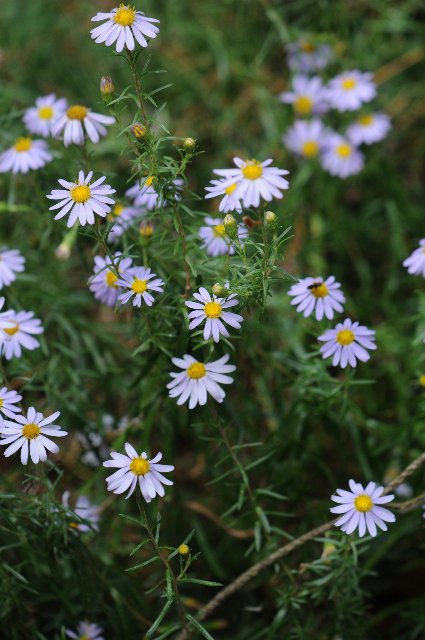 The genus for flax-leaved stiff-aster (Ionactis linariifolia), Ionactis, is a third-declension Latin noun; unlike the first-declension nouns ending in "-a" (feminine) "-us" (masculine) or "-um" (neuter), the grammatical gender of such nouns is not immediately clear, and as such, people often use alternate endings on the epithets of scientific names, which are adjectives to describe the nouns, here linariifolia, which means the leaves resemble those of the Linaria genus. Photo © Todd Boland, CC BY 4.0, Source.
The genus for flax-leaved stiff-aster (Ionactis linariifolia), Ionactis, is a third-declension Latin noun; unlike the first-declension nouns ending in "-a" (feminine) "-us" (masculine) or "-um" (neuter), the grammatical gender of such nouns is not immediately clear, and as such, people often use alternate endings on the epithets of scientific names, which are adjectives to describe the nouns, here linariifolia, which means the leaves resemble those of the Linaria genus. Photo © Todd Boland, CC BY 4.0, Source.Besides alternate endings, other common misspellings include adding or omitting an "i" or "a" (mac/mc) or hyphens, or exchanging "ae" for "oe" or "i" for "y". Some such examples include pecan (Carya illinoinensis) being misspelled Carya illinoensis (missing "i"), tufted evening primrose (Oenothera caespitosa) being misspelled Oenothera cespitosa, or the stansbury cliffrose (Purshia stansburiana) being misspelled Purshia stansburyana.
We do not exhaustively list all possible mispellings and typos; our site does not perform a "fuzzy search", and part of the reason why is that we want you to be able to be certain when a search does not return anything, a limitation of approximate search matches that can make it hard to figure out when a certain record does not exist. If you type an exact name into our search, and no results are returned, you can be certain that there is no corresponding record by that name. However, we are trying to list as many misspellings and alternate endings as we can, whenever they have been published. Keep in mind our listing of these alternate entries is an ongoing process and is far from complete; we are focusing on the more commonly-used ones first to maximize utility. If we find such a spelling or ending in any published source and bring it to our attention, we will add it.
Tip For Searches When Uncertain of Spelling
Our search functions differently from a typical web search, in that it does not split the search into words. Understanding the differences can help you use it more effectively, as it can do some things that a typical web search cannot do.The search returns only exact matches to what you type in, but it does return matches to incomplete names. Thus if you are uncertain of some aspect of the spelling, an easy way to search is to leave off the portion of the name you are uncertain about. For example, suppose you have trouble spelling the genus "Symphyotrichum"; you can easily locate this genus in your search by typing in the first few letters "Sym" and then you can find the correct spelling in the results, and copy-and-paste this, or just remember it. You can also use these sorts of truncated searches to save time. For example, if searching for the unwieldly crookedstem aster (Symphyotrichum prenanthoides), you can type in only "um pre" and it will return this species (and in this case only this species, believe it or not!)
Note however that the search must only be truncated at the beginning or end of the full search string. If you type in "Sym pre" it will not match anything.
Alternate Common Names Are Matched Similarly
The features above are richest for scientific names, but we have also implemented the same type of matching for common names. As we explained last spring, we give preference to better common names when possible, while retaining older, problematic names as well as adding as many alternate names as we can find.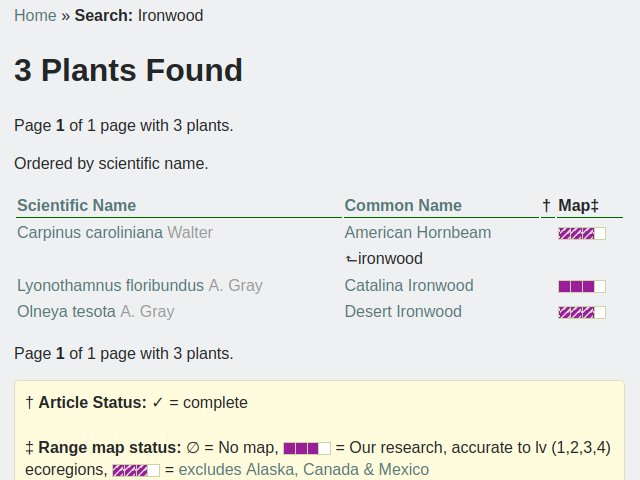 This screenshot shows a search for "ironwood", which can refer both to the American hornbeam (Carpinus caroliniana) as well as two West-Coast species, the Catalina ironwood (Lyonothamnus floribundus) and desert ironwood (Olneya tesota).
This screenshot shows a search for "ironwood", which can refer both to the American hornbeam (Carpinus caroliniana) as well as two West-Coast species, the Catalina ironwood (Lyonothamnus floribundus) and desert ironwood (Olneya tesota).As with the rest of our site, the search is a work-in-progress, so it will get better as we continue adding alternate names.
We are grateful to all our donors who help support this work along with all of the other aspects of our site. This post only covers one of many things we have been working on lately. Other highlights include that we have begun publishing goldenrod (Solidago) ID guides, we have built hundreds of more range maps, completing many of them into Canada and Alaska, and we have also added the ability to credit authors/coauthors, reviewers, editors, and other contributors on our articles, laying the foundation for more people to contribute to our site. We hope to publish more posts on other updates soon.
For now, enjoy the improved search!
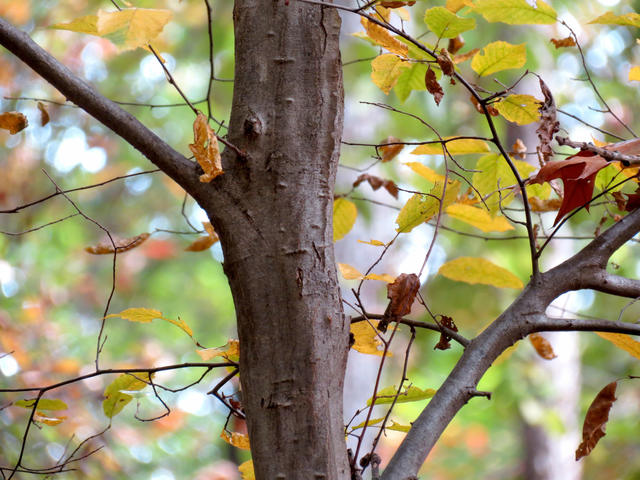 The aforementioned American hornbeam (Carpinus caroliniana), also known as musclewood, blue beech, and ironwood, now not only appears in searches for these names, but the search clearly denotes which name was matched, and that it is pointing to this species. Photo © Katja Schulz, CC BY 4.0, Source.
The aforementioned American hornbeam (Carpinus caroliniana), also known as musclewood, blue beech, and ironwood, now not only appears in searches for these names, but the search clearly denotes which name was matched, and that it is pointing to this species. Photo © Katja Schulz, CC BY 4.0, Source.Archive of All Blogs
The Bias Against Tall Plants, November 11th, 2025
A Focus on Goldenrods (Solidago sp.), July 23rd, 2025
Disturbance and its Role in Plant Habitat Preferences, May 29th, 2025
What "Native" or "Introduced" Mean: Myths and Misconceptions, March 11th, 2025
Smarter & More Informative Search Results, January 13th, 2025
The Effect of the 2024 US Election on Plant Biodiversity and bplant.org, October 30th, 2024
The Problems With Nursery-Bought Plants, And The Solutions, October 8th, 2024
More Databases Linked & Search Improvements for Scientific Names, July 9th, 2024
Choosing The Best Common Names For Plants: Challenges & Solutions, April 19th, 2024
Range Map & Taxonomic Update Progress, January 31st, 2024
Giving Thanks To Everyone We Rely On, November 22nd, 2023
Thinking More Deeply About Habitat, April 5th, 2023
2022 Year-End Summary: Successes & New Goals, February 15th, 2023
New Databases Linked: Flora of North America & NatureServe Explorer, November 11th, 2022
All Range Maps 2nd Generation, Taxonomic Updates, & Fundraising Goal Met!, September 29th, 2022
More Range Map Improvements, POWO Interlinking, And Notes Fields, June 7th, 2022
Ecoregion-Based Plant Lists and Search, March 30th, 2022
Progress Updates on Range Maps and More, February 10th, 2022
The Vision for bplant.org, December 9th, 2021
New Server: Software & Hardware, August 30th, 2021
More & Improved Plant Range Maps, July 19th, 2021
A Control Section for Invasive Plants, April 15th, 2021
Progress Bars & State Ecoregion Legends, March 11th, 2021
Our 2020 Achievements, February 9th, 2021
Interlinking Databases for Plant Research, November 11th, 2020
A New Homepage, Highlighting Our Articles, July 29th, 2020
A False Recovery, But North Carolina's Ecoregions are Complete!, June 9th, 2020
We're Back After COVID-19 Setbacks, April 3rd, 2020
Help Us Find Ecoregion Photos, February 27th, 2020
What We Achieved in 2019, December 30th, 2019
Plant Comparison and ID Guides, October 30th, 2019
We Are Now Accepting Donations, October 14th, 2019
US State Ecoregion Maps, New Footer, Ecoregion Article Progress, and References, September 19th, 2019
Tentative Range Maps of Native Plants, August 12th, 2019
Ecoregion Locator and Interactive Maps, July 10th, 2019
Using Ecoregions Over Political Boundaries, May 13th, 2019
How We Handle Wild vs Cultivated Plants, April 16th, 2019
A Blog To Keep People Updated On Our Progress, April 8th, 2019
Sign Up
Want to get notified of our progress? Sign up for the bplant.org interest list!


